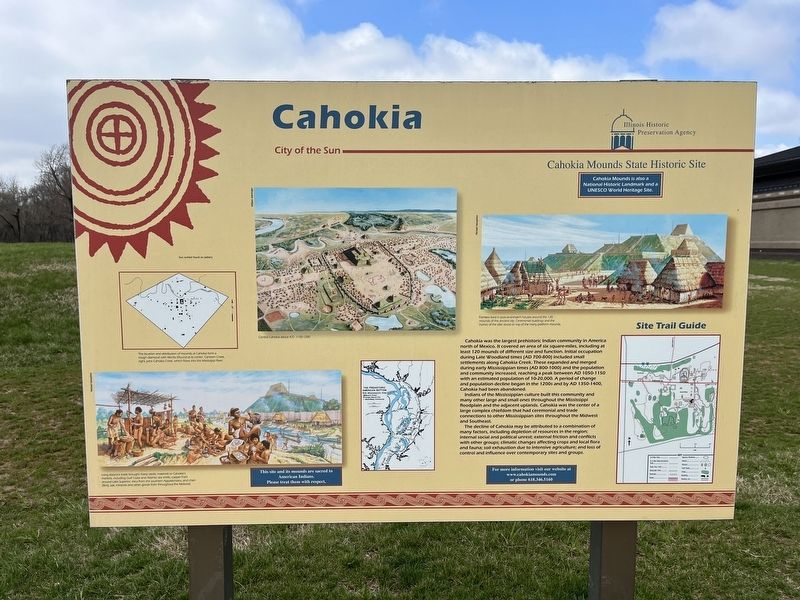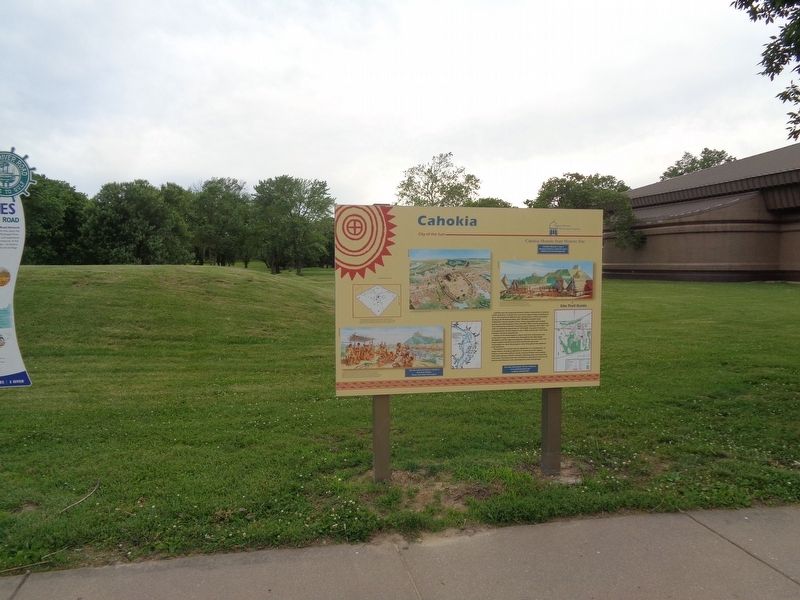Near Collinsville in St. Clair County, Illinois — The American Midwest (Great Lakes)
Cahokia
City of the Sun
Cahokia was the largest prehistoric Indian community in America north of Mexico. It covered an area of six square-miles, including at least 120 mounds of different size and function. Initial occupation during Late Woodland times (AD 700-800) included small settlements along Cahokia Creek. These expanded and merged during early Mississippian times (AD 800-1000) and the population and community increased, reaching a peak between AD 1050-1150 with an estimated population of 10-20,000. A period of change and population decline began in the 1200s and by AD 1350-1400, Cahokia had been abandoned.
Indians of the Mississippian culture built this community and many other large and small ones throughout the Mississippi floodplain and the adjacent uplands. Cahokia was the center of a large complex chiefdom that had ceremonial and trade connections to other Mississippian sites throughout the Midwest and Southeast.
The decline of Cahokia may be attributed to a combination of many factors, including depletion of resources in the region; internal social and political unrest; external friction and conflicts with other groups; climatic changes affecting crops and local flora and fauna; soil exhaustion due to intensive agriculture; and loss of control and influence over contemporary sites and groups.
[Captions:]
The location and distribution of mounds at Cahokia form a rough diamond with Monks Mound at its center. Canteen Creek, right, joins Cahokia Creek, which flows into the Mississippi River.
Long distance trade brought many exotic materials to Cahokia’s markets, including Gulf Coast and Atlantic sea shells; copper from around Lake Superior; mica from the southern Appalachians; and chert (flint), salt, minerals and other goods from throughout the Midwest.
Central Cahokia about A.D. 1150-1200
Families lived in pole-and-thatch houses around the 120 mounds of this ancient city. Ceremonial buildings and the homes of the elite stood on top of the many platform mounds.
Erected by Illinois Historic Preservation Agency.
Topics. This historical marker is listed in these topic lists: Anthropology & Archaeology • Native Americans.
Location. 38° 39.256′ N, 90° 3.54′ W. Marker is near Collinsville, Illinois, in St. Clair County. Marker is on Ramey Drive south of Collinsville Road, on the right when traveling south. Touch for map. Marker is at or near this postal address: 30 Ramey Dr, Collinsville IL 62234, United States of America. Touch for directions.
Other nearby markers. At least 8 other markers are within walking distance of this marker. Cahokia Mounds (here, next to this marker); You Are Walking Where a Cahokia Neighborhood Once Stood (within shouting distance of this marker); Interpretive Center Tract (about 600 feet away, measured in a direct line); Grand Plaza (about 600 feet away); Mound 55 (about 700 feet away); The South Stockade (approx. 0.2 miles away); Mound 50 (approx. ¼ mile away); The Twin Mounds (approx. ¼ mile away). Touch for a list and map of all markers in Collinsville.
Credits. This page was last revised on April 2, 2023. It was originally submitted on April 2, 2023, by Jason Voigt of Glen Carbon, Illinois. This page has been viewed 57 times since then and 17 times this year. Photos: 1. submitted on April 2, 2023, by Devry Becker Jones of Washington, District of Columbia. 2. submitted on June 9, 2020, by Jason Voigt of Glen Carbon, Illinois. • Devry Becker Jones was the editor who published this page.

